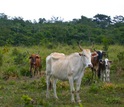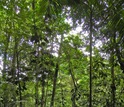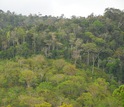Hola amigos: A VUELO DE UN QUINDE EL BLOG., la Fundación Nacional de Ciencias de Los Estados Unidos, nos alcanza la información que hay una regeneración natural de bosques tropicales en América Latina, que de alguna manera ayudan a mitigar el cambio climático global.
More information..........
New study looks at 43 regions in Latin America
 Credit and Larger Version |
This article is the ninth in a series on NSF's Long Term Research in Environmental Biology (LTREB) awards. Visit parts one, two, three, four, five, six , seven and eight.
Climate scientists have long recognized the importance of forest conservation and forest regrowth in climate mitigation and carbon sequestration -- capturing carbon dioxide (CO2) from the atmosphere. But the detailed information required to make accurate estimates of this potential has remained elusive.
Now, an international team of 60 scientists, working together as the 2ndFOR Network, has completed studies on the effects of forest conservation and secondary forest regeneration across 43 regions in Latin America.
In an article titled "Carbon sequestration potential of second-growth forest regeneration in the Latin American tropics," published today in the journal Science Advances, University of Connecticut ecologist and evolutionary biologist Robin Chazdon and her colleagues report a series of new findings.
Long-term studies
"This study uses knowledge gained from long-term studies of tropical forests to address a pressing societal need," says Saran Twombly, program director in the National Science Foundation (NSF) Division of Environmental Biology, which funded the research through NSF's Long Term Research in Environmental Biology, and Dynamics of Coupled Natural and Human Systems, programs. "It shows that natural processes alone can provide a solution to the excess carbon dioxide threatening the planet."
The studies aimed to model the areas covered by regrowth forests across the lowlands of the Latin American Tropics in two age classes; to project potential above-ground carbon storage in these young forests over four decades; and to illustrate alternative scenarios for carbon storage where 0-80 percent of these forests are allowed to regenerate.
Chazdon says that "this research is vital because actively growing vegetation takes carbon dioxide out of the atmosphere and converts it to plant tissues such as wood and leaves. Old-growth forests contain large stocks of carbon in their biomass. When these forests are cleared and burned, this carbon is released into the atmosphere, contributing to global warming. This is one of the main reasons why it is important to halt deforestation."
But scientists have also learned that when forests regrow, their carbon stocks in above-ground biomass increase over time, depending on climate, prior land use and features of the surrounding landscape.
"This regrowth can happen without planting trees, through the spontaneous process of natural regeneration," says Chazdon. "This is a low-cost way of restoring forests and of reaching carbon mitigation goals."
Major findings
Among the major findings of the study are:
- Models of forest age in 2008 show that 17 percent of the forest area in lowland Latin America consists of young second-growth forest (1-20 years) and 11 percent consists of intermediate age forest (20-60 years).
- Assuming that 100 percent of the second growth persists and regenerates over 40 years, carbon storage capacity doubles in young second growth and increases by 120 percent in intermediate age forests. In both forest age classes, a net gain of 8.48 trillion kilograms of carbon is stored over 40 years.
- This amount is equivalent to 31.09 trillion kilograms of CO2, which equals all the carbon emissions from fossil fuel use and other industrial processes in all the countries of Latin America and the Caribbean from 1993 to 2014.
- Ten countries account for 95 percent of this carbon storage potential, led by Brazil, Colombia, Venezuela and Mexico.
Forest-based climate change solutions
Chazdon says that, remarkably, this huge amount of carbon storage doesn't require costly tree plantings or conversion of farmlands. "It is all based on natural forest regrowth and only requires persistence and protection of the young forests and abandoned agricultural fields."
Forest-based solutions provide many other benefits, including hydrologic regulation, habitats and corridors for conserving biodiversity, and provision of non-timber forest products to local people, Chazdon says.
Prior carbon storage efforts have placed emphasis on avoiding deforestation. But, Chazdon says, "avoiding deforestation and supporting forest regeneration are complementary and mutually reinforcing activities."
While forest regeneration and protection alone cannot fully compensate for greenhouse gas emissions on a global scale, researchers say the study affirms that this strategy can contribute significantly toward reaching national and international carbon mitigation targets.
-NSF-
Media Contacts Cheryl Dybas, NSF, (703) 292-7734,cdybas@nsf.gov
Sheila Foran, UCONN, (860) 486-5385,
Sheila Foran, UCONN, (860) 486-5385,
Related WebsitesNSF Grant: LTREB: Successional Pathways and Rates of Change in Tropical Forests of Brazil, Costa Rica and Mexico:
http://www.nsf.gov/awardsearch/showAward?AWD_ID=1147429&HistoricalAwards=false
NSF Grant: CNH: The Emergence of Adaptive Governance Arrangements for Tropical Forest Ecosystems:
NSF Grant: CNH: The Emergence of Adaptive Governance Arrangements for Tropical Forest Ecosystems:
The National Science Foundation (NSF) is an independent federal agency that supports fundamental research and education across all fields of science and engineering. In fiscal year (FY) 2016, its budget is $7.5 billion. NSF funds reach all 50 states through grants to nearly 2,000 colleges, universities and other institutions. Each year, NSF receives more than 48,000 competitive proposals for funding and makes about 12,000 new funding awards. NSF also awards about $626 million in professional and service contracts yearly.
Useful NSF Web Sites:
NSF Home Page:
http://www.nsf.govNSF Home Page:
NSF News:
http://www.nsf.gov/news/
For the News Media:
http://www.nsf.gov/news/newsroom.jsp
Science and Engineering Statistics:
http://www.nsf.gov/statistics/
Awards Searches:
http://www.nsf.gov/awardsearch/

Pasture with young second-growth forest in the background in Chiapas, Mexico.
Credit and Larger Version

An 18-year-old second-growth wet tropical forest in Costa Rica that was once a pasture.
Credit and Larger Version

Extensive natural regeneration of Atlantic rainforest at Rio Cachoiera Nature Reserve in Brazil.
Credit and Larger Version

Old-growth Atlantic rainforest in background with second-growth in foreground in Bahia, Brazil.
Credit and Larger Version
The National Science Foundation (NSF)
Guillermo Gonzalo Sánchez Achutegui
ayabaca@gmail.com
ayabaca@hotmail.com
ayabaca@yahoo.com
Inscríbete en el Foro del blog y participa : A Vuelo De Un Quinde - El Foro!

No hay comentarios:
Publicar un comentario